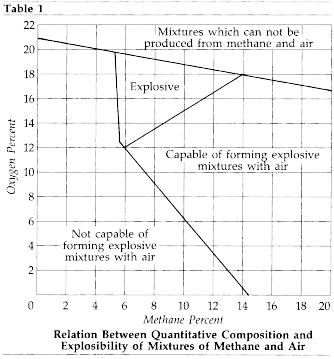Title 30
SECTION 57.22003
57.22003 Mine category or subcategory.
§ 57.22003 Mine category or subcategory.(a) All underground mines, and the surface mills of Subcategory I-C mines (gilsonite), shall be placed into one of the following categories or subcategories to protect persons against the hazards of methane and dusts containing volatile matter. Categories and subcategories are defined as follows:
(1) Category I applies to mines that operate within a combustible ore body and either liberate methane or have the potential to liberate methane based on the history of the mine or the geological area in which the mine is located. Category I is divided into Subcategories I-A, I-B, and I-C as follows:
(i) Subcategory I-A applies to mines that operate within a combustible ore body and liberate methane and in which -
(A) A concentration of 0.25 percent or more methane has been detected in the mine atmosphere and confirmed by laboratory analysis; or
(B) An ignition of methane has occurred.
(ii) Subcategory I-B applies to mines that operate within a combustible ore body and have the potential to liberate methane based on the history of the mine or geological area in which the mine is located and in which -
(A) A concentration of 0.25 percent or more methane has not been detected in the mine atmosphere; and
(B) An ignition of methane has not occurred.
(iii) Subcategory I-C applies to mines in which the product extracted is combustible and the dust has a volatile matter content of 60 percent or more measured on a moisture free basis 1 .
1 Measured by the American Society for Testing and Materials, ASTM D 3175-82, Standard Test Method for Volatile Matter in the Analysis Sample of Coal and Coke. (This document is available at any Metal and Nonmetal Mine Safety and Health District Office of the Mine Safety and Health Administration).
(2) Category II applies to domal salt mines where the history of the mine or geological area indicates the occurrence of or the potential for an outburst. Category II is divided into Subcategories II-A and II-B as follows:
(i) Subcategory II-A applies to domal salt mines where an outburst reportable under § 57.22004(c)(1) has occurred.
(ii) Subcategory II-B applies to domal salt mines where an outburst reportable under § 57.22004(c)(1) has not occurred, but which have the potential for an outburst based on the history of the mine or geological area in which the mine is located.
(3) Category III applies to mines in which noncombustible ore is extracted and which liberate a concentration of methane that is explosive, or is capable of forming explosive mixtures with air, or have the potential to do so based on the history of the mine or the geological area in which the mine is located. The concentration of methane in such mines is explosive or is capable of forming explosive mixtures if mixed with air as illustrated by Table 1 below, entitled “Relation Between Quantitative Composition and Explosibility of Mixtures of Methane and Air”.

(4) Category IV applies to mines in which noncombustible ore is extracted and which liberate a concentration of methane that is not explosive nor capable of forming explosive mixtures with air based on the history of the mine or the geological area in which the mine is located. The concentration of methane in such mines is not explosive nor capable of forming explosive mixtures if mixed with air as illustrated by Table 1 above, entitled “Relation Between Quantitative Composition and Explosibility of Mixtures of Methane and Air”.
(5) Category V applies to petroleum mines. Category V is divided into Subcategories V-A and V-B as follows:
(i) Subcategory V-A applies to petroleum mines that operate entirely or partially within an oil reservoir; and all other petroleum mines in which -
(A) A concentration of 0.25 percent or more methane has been detected in the mine atmosphere and confirmed by laboratory analysis; or
(B) An ignition of methane has occurred.
(ii) Subcategory V-B applies to petroleum mines that operate outside of and drill into an oil reservoir and in which -
(A) A concentration of 0.25 percent or more methane has not been detected in the mine atmosphere; and
(B) An ignition of methane has not occurred.
(6) Category VI applies to mines in which the presence of methane has not been established and are not included in another category or subcategory.
(b) Category or subcategory placement or change in placement shall include consideration of the following:
(1) The history and geology of the mine or of the geological area in which the mine is located;
(2) The ore body and host rock;
(3) The character, amount, duration, origin, and nature of methane emission and the presence of explosive dust and inert gases; and
(4) Whether or not conditions encountered during primary or access development are transient or permanent.
(c)(1) Gas samples for the purpose of category or subcategory placement or change in placement, and for determining action levels, shall be taken in the mine atmosphere. Gas samples taken to determine the nature and extent of an occurrence under § 57.22004 (c) and (d) may be taken at any location, including the source, point of entry and the mine atmosphere.
(2) Tests for methane shall be made with hand-held methanometers, methane monitors, atmospheric monitoring systems, devices used to provide laboratory analysis of samples, or with other equally effective sampling devices. However, only methane samples that have been confirmed by laboratory analysis shall be used for category or subcategory placement or change in placement.
(d) Each mine and mill shall be required to operate in accordance with the safety standards applicable to its particular category or subcategory.